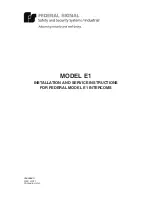
RedLab 1008 User's Guide
Functional Details
25
Combining these two error sources in Figure 14, we have a plot of the error band of the RedLab 1008 for the
±10 V range. This is a graphical version of the typical accuracy specification of the product.
The accuracy plots in Figure 14 are drawn for clarity and are not drawn to scale
-FS
+ FS
Input Voltage
0
4095
9.77mV
2048
Output Code
Ideal
Ideal + 9.77mV + 20 mV
Ideal + 9.77mV + 20 mV
Ideal -(9.77mV + 20 mV)
Ideal -(9.77mV + 20 mV)
Ideal
Ideal + 9.77mV + 20 mV
Figure 14. Error band plot
Channel gain queue
The RedLab 1008's channel gain queue feature allows you to set up a scan sequence with a unique per-channel
gain setting and channel sequence.
The channel gain queue feature removes the restriction of using an ascending channel sequence at a fixed gain.
This feature creates a channel list which is written to local memory on the RedLab 1008. This list is made up of
a channel number and range setting. An example of a four-element list is shown in the table below.
Sample channel gain queue list
Element
Channel
Range
0
CH0
BIP10V
1
CH0
BIP5V
2
CH7
BIP10V
3
CH2
BIP1V
When a scan begins with the gain queue enabled, the RedLab 1008 reads the first element, sets the appropriate
channel number and range, and then acquires a sample. The properties of the next element are then retrieved,
and another sample is acquired. This sequence continues until all elements in the gain queue have been selected.
When the end of the channel list is detected, the sequence returns to the first element in the list.
This sequence repeats until the specified number of samples is gathered. You must carefully match the gain to
the expected voltage range on the associated channel—otherwise, an over range condition can occur. Although
this condition does not damage the RedLab 1008, it does produce a useless full-scale reading. It can also
introduce a long recovery time from saturation, which can affect the next measurement in the queue.
Summary of Contents for RedLab 1008
Page 1: ......










































